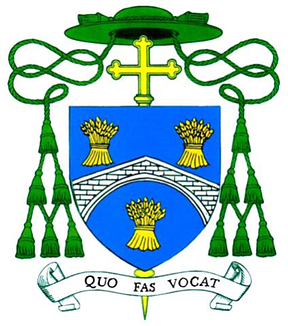The Bishop
The Right Reverend John Stanley Kenneth Arnold, Eleventh Bishop of Salford
 Bishop John Arnold was born in Sheffield on 12th June 1953. He is a graduate of the University of Oxford, where he studied Law at Trinity College. He was called to the bar in the Middle Temple in 1976 after studying at the Council of Legal Education.
Bishop John Arnold was born in Sheffield on 12th June 1953. He is a graduate of the University of Oxford, where he studied Law at Trinity College. He was called to the bar in the Middle Temple in 1976 after studying at the Council of Legal Education.
After entering the novitiate of the Institute of Charity (Rosminians) and taking simple vows in 1978, he began his studies at the Gregorian University in Rome. In 1981 Bishop John transferred to the Archdiocese of Westminster, continuing his studies at the Venerable English College Rome and completing both a licence and a doctorate in Canon Law. John Arnold was ordained Deacon by Cardinal Basil Hume on 27th November 1982, and Priest on 16th July 1983, the Feast of Our Lady of Mount Carmel. He subsequently continued his studies in Rome, returning to Westminster to be appointed as a Chaplain at Westminster Cathedral, with responsibilities for the Westminster Hospital. In 1989, Father John was appointed Sub-Administrator of Westminster Cathedral serving in that role until 1993, when he was appointed as Parish Priest of Our Lady of Mount Carmel and St George in Enfield, serving also as Promoter of Justice.
Other roles have included assisting in the compilation of two books published by Cardinal Hume; “Light in the Lord” and “Towards a Civilisation of Love”. Having contributed to “AIDS: Meeting the Community Challenge”, he published “The Quality of Mercy, a fresh look at the Sacrament of Reconciliation” in 1993.
In 2001 Cardinal Cormac Murphy-O’Connor appointed Father John as Chancellor and Vicar General of the Archdiocese of Westminster, being named by Pope John Paul II as a Chaplain to the Papal Household in 2003. He was ordained Bishop on 2nd February 2006, assigned the Titular See of Lindisfarne and appointed as an Auxiliary Bishop of the Archdiocese of Westminster.
Pope Francis appointed Bishop John Arnold as the Bishop of Salford on Tuesday, 30th September 2014. His installation at Salford Cathedral took place on Monday 8th December 2014, the Feast of the Immaculate Conception.
Bishop John is the Bishop Conference Spokesperson for the Environment and a former Chair of CAFOD’s Board of Trustees.
Bishop John’s Coat of Arms
Motto: “Quo fas vocat” “Go where Divine Providence calls you”
Bishop John explains: “This was the motto of Lord Oscar Murton of Lindisfarne who died in 2009. I met him at the time of my ordination as an auxiliary bishop, in 2006. As an auxiliary bishop I was given the title of “Bishop of Lindisfarne” and he asked me if I would like to take his motto. The meaning has significance for me in that seeking to discern and live according to Divine Providence is the particular character of the Institute of Charity (The Rosminians), the religious order who taught in two schools that I attended. I also entered the Institute of Charity and was a member for five years as I began my formation for priesthood. Divine Providence is closely associated with the seeking of “God in all things” which lies at the heart of the spirituality which guided the monks of Lindisfarne in the times when Holy Island was the cradle of Christianity in the Seventh and Eighth Centuries. I have always tried to recognise Divine Providence in my life, particularly through the promise of obedience that I made at the time of my ordination to the Diaconate. It is that sense of willing obedience to Pope Francis that brings me to accept his wish to appoint me to the Diocese of Salford.”
The Shield
The sheaves of wheat are representative of Bishop John’s native town of Sheffield (originally Sheaf-Field) and they also represent the important image of the Sower going out to sow as recorded in the Gospels. The bridge is representative of Bishop John’s pastoral intent of building bridges and collaboration through Ecumenical and Interfaith dialogue. The bridge also represents a hint of the causeway which joins Lindisfarne (Bishop John’s former title) to the mainland.

Pastoral Letters
Here you can find a copy and short summary of all Bishop John’s Pastoral Letters.
Learn More